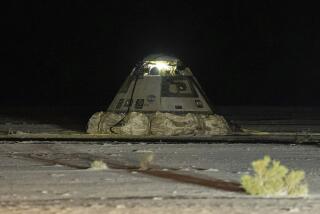Astronauts Fail to Rescue Dead Satellite : No Response After ‘Fly Swatters’ Catch, Tug on Suspect Lever
HOUSTON — The crew of the space shuttle Discovery successfully snared the activating lever of a dormant satellite Wednesday and gave it two strong pulls, but the rescue attempt failed when the satellite refused to spring to life.
It was a profound disappointment for the seven-member crew of Discovery, as well as for scores of engineers on the ground.
“You did everything you possibly could,” David Hilmers at Mission Control in Houston told the crew. “It was a great job.”
Feverish Activity
The improvised rescue attempt, put together over three days of feverish activity on the ground and aboard the shuttle, went smoothly in its early stages. Handmade plastic loops, nicknamed “fly swatters” by space agency officials, reached forward from the 50-foot robot arm and caught the lever as it rotated by on the spinning satellite.
But the seven-ton satellite, valued at more than $80 million, remained dead, drifting uselessly more than 200 miles above the earth.
Officials from Hughes Communications Services Inc., the satellite’s owner, said at a news conference that television replays showed that the lever probably was already in the correct position before the rescue attempt.
“The lever was open,” said Steve Dorfman, president of Hughes Communications. “There was (still) some hope that maybe it hadn’t fully activated the switches. But it was hit hard enough by the fly swatter that it lays to rest the issue of whether the lever was operating properly.”
Dorfman said that the satellite’s troubles might have been caused by multiple internal breakdowns--what he termed “pathological circumstances.”
After the failure of the rescue effort, a subdued mood descended over engineers and other officials at the Lyndon B. Johnson Space Center here. Muted conversations between Discovery and Mission Control contrasted sharply with the cheerful exchanges of the last couple of days.
Jay Greene, flight director for the shuttle mission, said: “It was one helluva job by everyone involved. We were getting on a high (over the last three days) as everything came together. It would have been nice if it all came together with the right outcome. Unfortunately, it didn’t.”
Rocket Didn’t Fire
The rescue mission was put into motion on Sunday when the Hughes satellite, known as Leasat 3, failed to perform a series of maneuvers, including firing the rocket that would put it into proper orbit, after being ejected from the shuttle. Engineers from Hughes and the National Aeronautics and Space Administration concluded that the most likely culprit was a four-inch activating lever that should have flipped to an open position during the ejection process, starting the maneuvers.
The solution called for the shuttle crew to fashion plastic loops from the covers of their flight manuals and attach the loops to the shuttle’s robot arm. The attachment, which required a three-hour space walk by two astronauts, was completed Tuesday.
Early Wednesday morning, the shuttle positioned itself next to the dormant satellite. Then, with great delicacy, the robot arm and loops were eased forward by astronaut M. Rhea Seddon until the loops were brushing the side of the slowly revolving satellite.
Her first attempt to snag the lever missed, but the second and third passes caught it dead center, giving firm pulls. After each pull, the loops tore away, as planned, but on the next revolution the lever could be seen in exactly the same position.
The futile rescue effort left the future of the satellite very much in doubt. Over the next several months, Dorfman said, Hughes would analyze the breakdown, and he did not rule out another attempt to activate the satellite on a future shuttle mission. “I think there are possibilities,” he said.
To Reimburse NASA
Dorfman said also that Hughes would reimburse NASA for the rescue attempt, but NASA officials said that they could not yet estimate the cost. Last year, NASA charged $5.3 million for the retrieval of two other Hughes satellites that went awry after being launched by the shuttle.
However, retrieval of this satellite is far less likely. The self-contained rocket engines that were to push it to a higher orbit remain loaded with nearly four tons of fuel. They would be a substantial danger to the shuttle craft and crew. One NASA official likened the unfired satellite to a stick of dynamite connected to a faulty fuse.
To date, shuttle missions have launched 17 satellites. Of those, three--including Leasat 3--have experienced serious difficulties and one other has lost part of its communications capability.
Hughes executives said that financial liability for the loss of the satellite now rests with a consortium of insurance underwriters, led by Intec of Washington, D.C. The satellite was insured for about $85 million, which will allow Hughes to build a replacement, company spokesmen said.
A series of satellite launching problems, including the two Hughes satellites lost last year, has led to steep increases in insurance premiums, from less than 10% of a satellite’s value to 18% or 20%.
Meanwhile, given the choice of two landing days, mission commander Karol J. Bobko chose Friday. If good weather prevails, as is predicted, the shuttle will come down at Kennedy Space Center in Florida. The backup landing site is Edwards Air Force Base in California.
In addition to Bobko and Seddon, the crew members are S. David Griggs and Jeffrey A. Hoffman, who made the space walk Tuesday, Donald E. Williams, Charles D. Walker and Sen. Jake Garn (R-Utah).
More to Read
Sign up for Essential California
The most important California stories and recommendations in your inbox every morning.
You may occasionally receive promotional content from the Los Angeles Times.









